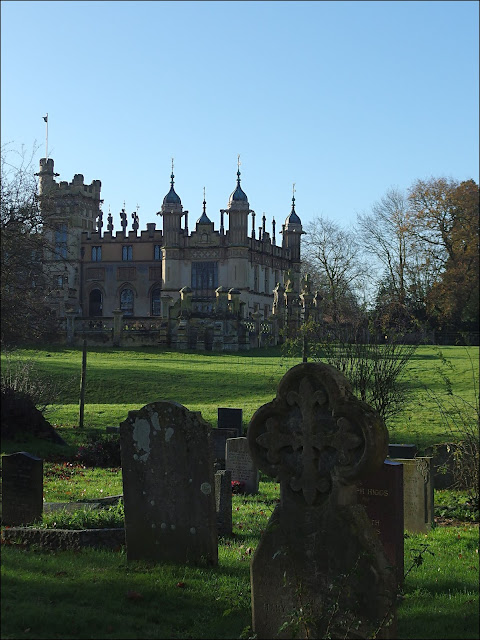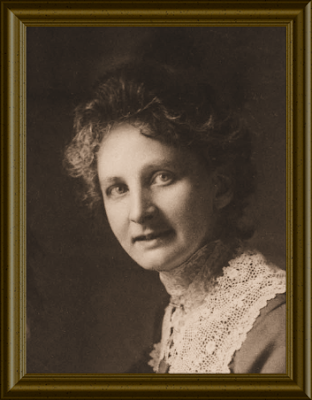Today, Friday, I went for a walk in the grounds of Knebworth House in Hertfordshire, a place where such diverse personalities as Winston Churchill and Freddie Mercury have strutted their stuff (the former - a friend of the well-connected Lytton family who owned the house for centuries, the latter - at one of the many outdoor rock festivals which have helped pay for the upkeep of the mansion in recent decades). The house is closed for the winter but the footpaths through the grounds are still open.
I'll show you some more of the walk in the next post but for now I'd like to tell you a little about some of the Lyttons. The house hasn't always looked like this; part of the old house is in there somewhere but the fantastic concoction we see today is the result of Victorian renovations carried out for Elizabeth Bulwer-Lytton, whom a biographer once described as "that odd rich old woman". Besides the fantastical appearance of her abode she also carried out a lifelong argument with the vicar of the church which stands just a short distance away in the grounds.
Whatever the cause of the disagreement it led to her banning her own employees (most of the local people) from attending church. She even carried on the argument from beyond the grave as she had a mausoleum built on her own property rather than being interred in the churchyard with her ancestors.
Whatever her other failings, her son Edward was greatly affected by his mother's death and ordered that her room must be preserved as it was at her death - and it's little changed to this day. Not that he was immune to his mother's quarrelsome temperament; when he married in 1827 she disapproved of the match and withdrew his allowance, forcing him to work for a living. He worked tirelessly at a writing career as well as being a politician but, despite considerable success in both careers, their extravagant lifestyle put the marriage under stress and the couple separated.
He wrote novels, plays and poetry in a wide variety of genres and though his work is largely forgotten today in his day he was regarded as one of England's foremost writers, he was as famous in his day as the young writer who came to visit in later years - Charles Dickens, no less.
Even if you've never heard of Bulwer-Lytton's writing, you'll know some of the phrases which he introduced into the language - "the great unwashed", "pursuit of the almighty dollar" and "the pen is mightier than the sword" are all his. He also began one novel "It was a dark and stormy night...." and that has inspired not only Snoopy but also an annual competition for bad writing.
His wife - or rather his ex-wife - Rosina Bulwer Lytton also published a novel, "Cheveley, or the Man of Honour" which harshly lampooned her former husband. Then when he stood for parliament she spoke out against him with such venom that he had her committed to a lunatic asylum. Public protests led to her release but she continued her campaign against him for the rest of his days.
The couple had two children, one of whom, Robert Bulwer-Lytton, went on to become Viceroy of India. He and his wife Edith had five children who survived to adulthood, and it's their second daughter, Lady Constance Georgina Bulwer-Lytton, who is probably the most interesting.
She was born in Vienna, then spent her early years in India before coming to the family home at Knebworth. She rejected the aristocratic lifestyle and became reclusive. When she inherited £1,000 she gave it to Mary Neal's Esperance Club for working-class girls from London's East End. Through this connection she got to know many of the Suffragettes who were conducting a militant campaign to gain women the right to vote.
At first she was very much against the violent protests of the Suffragettes, but was eventually persuaded that no other course of action would be effective. In 1909 she was imprisoned twice for throwing stones at Lloyd George's car, but the authorities released her when they realised that she was the daughter of the former Viceroy of India and had a brother in the House of Lords. While in jail she self-mutilated cutting the letter "V" into her chest. She had intended to carve the words "Votes For Women", from her chest to her face, but was prevented from doing so by the prison guards. Upon her release she wrote letters complaining of the inequality of treatment for persons of differing backgrounds.
The following year she rejoined the Suffragettes under the name Jane Warton, had her hair cut in an unflattering style and dressed in dowdy clothes. She then deliberately got herself arrested again and joined the hunger strikes, which imprisoned Suffragettes were using to protest at the way in which they were being treated as criminals rather than political prisoners. This time the prison had no idea that they were dealing with a member of the aristocracy and she was brutally force fed. Upon her release she wrote of the mistreatment she had received and though some MPs disbelieved her story they were quickly countered by her brother. Shortly afterwards she had a heart attack and several strokes which affected one side of her body. Undaunted she wrote an influential book on prison reform with her other hand.
When the Suffragettes ceased their militant campaign at the outbreak of the First World War she lent her support to Marie Stopes and her fight to establish birth control clinics. As her health declined further she went to live with her mother at Homewood, a house on the Knebworth estate surrounded on three sides by woodland but with views out over farmland. She died aged just 54 and lies in the family mausoleum built for her disputatious great grandmother.
Take care.












Fascinating.
ReplyDeleteSuch an interesting family. Incredible that a woman could keep her staff from attending church!
ReplyDeleteWhen you look at those old estates and contemplate their sheer size, it is sobering to contemplate the difference between the wealth of the owners and the peasants all around. It is staggering to think that they could keep up those mansions purely on their personal wealth. No rock concerts back then.
ReplyDeleteWhat you need to consider is that money was an entirely different commodity throughout much of history. There was little security in keeping great amounts of the stuff and nothing much to invest it in other than ones own estate. There was little foreign travel, no yachts, no expensive cars or high tech to spend your money on. Even travel within the country was difficult and dangerous if you took money with you - that was the reason for the reciprocal hospitality enjoyed by the wealthy. While it was certainly a very unequal society, it was when that old system began to break down that the real problems started - exploitation of foreign lands, famine in Ireland, the Highland clearances and the misery associated with the industrial revolution. Nowadays the perspective is different but with 1% of the world's population owning over half the wealth we perhaps haven't progressed as much as we'd like to think. Now it's people like us who sit comfortably with our arms folded and look down on the world from our airplane seat and think how wonderful it all is.
DeleteWhat an interesting family story.
ReplyDeleteYou do find out some interesting history. Never been to One worth but remember the festival's.
ReplyDeleteReally interesting information about the Lytton family.
ReplyDeleteYears ago the Art Society that I belong to had a study day within the house. I was particularly interested in Lutyens connection to them through his marriage to Lady Emily Bulwer-Lytton, the sister of Constance Georgina. No doubt those connections played an instrumental role in Lutyens being awarded the position of designing and building New Delhi.
There is a large red brick church in Knebworth called St. Martins that was also designed by him.
I'm sure your right about the connections having influence on Lutyens commissions. I knew about the church and was hoping to pop in yesterday but in the end decided to leave it for another day. Lutyens also designed Homewood, the house in which Constance and her mother lived out their final years; it's interesting to note though that these great architects were far from perfect - Constance's mother called her bedroom "Vladivostock" because it was so cold and draughty!
DeleteWhat a fabulous place and thanks for the awesome read about the family. Your posts are always interesting to me :)
ReplyDeleteYou find the most interesting stories! I always enjoy these posts.
ReplyDeleteA fascinating post with delightful images.
ReplyDeleteThank you John.
Gosh Constance was a strong lady John, she had a very eventful fifty four years! Knebworth is an incroyable piece of architecture, added to through the years. I will think of Lytton now whenever I hear one of those very well known phrases 😀
ReplyDeleteQuite a story in the family! Excellent shots.
ReplyDeleteI loved reading this history of such an interesting family. Thank you for researching and sharing this with us. I will forever think of this post whenever I see the phrase..."It was a dark and stormy night..."
ReplyDeleteYour photos are fascinating, John, as is the story.
ReplyDeleteI had heard of both Edward Bulwer-Lytton as a writer and Lady Constance as a Suffragette but had no idea of their backgrounds and their connection with Knebworth. You have brought those connections together wonderfully, the story of Elizabeth Bulwer-Lytton and her argument with the vicar of the local church is very funny and yet quite sad at the same time. What a passionate family they were:)
ReplyDeleteWhat an interesting post and an interesting family. Elizabeth sounds like quite a character! Lovely photos of the house and grounds too.
ReplyDeleteI love reading all the info, though I know I won't retain it. But how do you know it all? Do you have to look it up, or what. And it would take all day to tell why I like or what I like about the pictures.
ReplyDeleteCan you imagine what it would cost to heat or cool that place. And imagine what it would take for window coverings!
I've lived in this area all my life, studied Geography at uni where I became interested in history and the development of the landscape over the centuries, worked in agriculture, worked as a walks leader for a firm offering walking holidays, through photography became aware of our architectural heritage and so on and so on. I still read a lot and that often makes me want to revisit these places. I do often have to look things up to make sure I've got my facts right and that often throws up a lot of stuff I wasn't aware of before. On the other hand I know nothing whatever about TV, films, celebrities, social media or much music after about 1980. As someone observed recently I know where all the footpaths and tracks go but have no idea about the main roads!
DeleteThank you for the answer! You know, I guess we are all that way in that we have our own particular things of interest. I really enjoy reading your posts, and had wondered if you had been a teacher. You remind me of my husband and his interests in war and all things guns and archery. And he used to be good at remembering facts about football/sports. At least before his stroke. And he is still interested, and still remembers but just has a hard time saying what he is thinking.
DeleteThe Odd and the Rich, I had to read this post. What an interesting and odd family.
ReplyDelete